LBYZOOL Activity 10-14 (Lab Exam 4)
0.0(0)
Card Sorting
1/281
Earn XP
Description and Tags
The Digestive System, The Respiratory System, The Circulatory System, The Urogenital System, & The Nervous System
Study Analytics
Name | Mastery | Learn | Test | Matching | Spaced |
|---|
No study sessions yet.
282 Terms
1
New cards
Digestive System
functions of organ system:
- ingestion of food
- physical and chemical digestion of food
- absorption of nutrient molecules
- elimination of undigested remains
- ingestion of food
- physical and chemical digestion of food
- absorption of nutrient molecules
- elimination of undigested remains
2
New cards
ingestion, digestion, absorption, and elimination
4 functions of digestive system
3
New cards
physical & chemical digestions
types of digestion
4
New cards
digestive tract & digestive glands
parts of digestive system
5
New cards
alimentary canal
aka digestive tract
6
New cards
mouth & cloaca
openings of alimentary canal
7
New cards
mouth, buccal cavity, pharynx, esophagus, stomach, small intestine, large intestine, rectum, & cloaca
parts of digestive tract
8
New cards
liver, gallbladder, & pancreas
accessory glands of digestive system
9
New cards
hepatic lobules, central vein, hepatic cells, & hepatic sinusoids
histology of liver
10
New cards
hepatic lobules
histology of liver:
- separated by connective tissue partition
- can observe portal canals
- separated by connective tissue partition
- can observe portal canals
11
New cards
septa
histology of liver:
connective tissue partition that separates hepatic lobules
connective tissue partition that separates hepatic lobules
12
New cards
portal veins, hepatic arteries, & bile duct
histology of liver:
portal canals
portal canals
13
New cards
central vein
histology of liver:
- at the center of the lobule
- arrow 1
- at the center of the lobule
- arrow 1
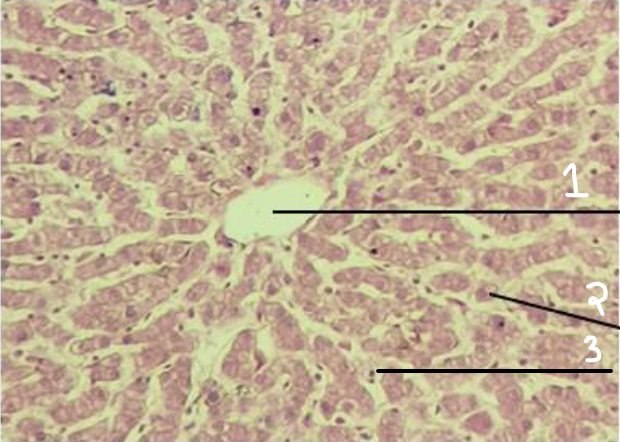
14
New cards
hepatocytes
histology of liver:
- hepatic cells
- radiating from the central vein and polygonal shape
- arrow 2
- hepatic cells
- radiating from the central vein and polygonal shape
- arrow 2
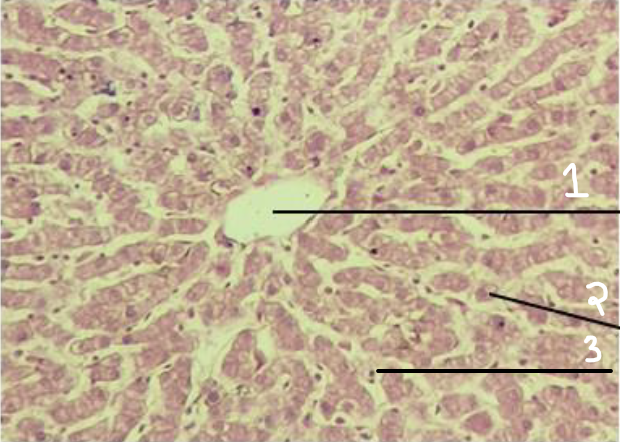
15
New cards
hepatic sinusoids
histology of liver:
- spaces in between hepatic plates
- arrow 3
- spaces in between hepatic plates
- arrow 3
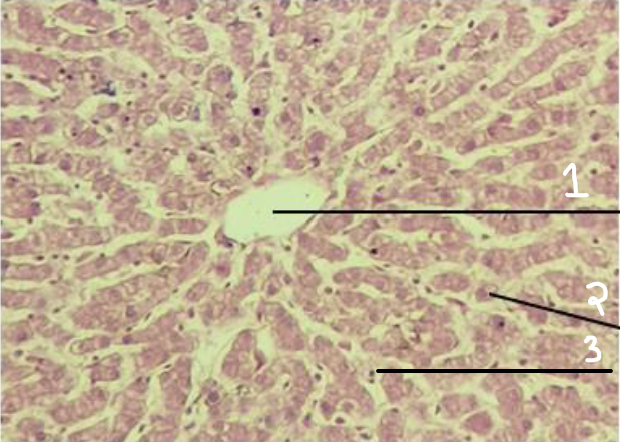
16
New cards
exocrine & endocrine
2 functions of pancreas
17
New cards
exocrine pancreas
histology of pancreas:
- pancreas that perform the digestive function
- contain acini
- pancreas that perform the digestive function
- contain acini
18
New cards
acini
histology of pancreas:
- consists of pyramidal-shaped cells surrounding a lumen
- arranged into small lobules
- secrete enzymes
- arrow 1
- consists of pyramidal-shaped cells surrounding a lumen
- arranged into small lobules
- secrete enzymes
- arrow 1
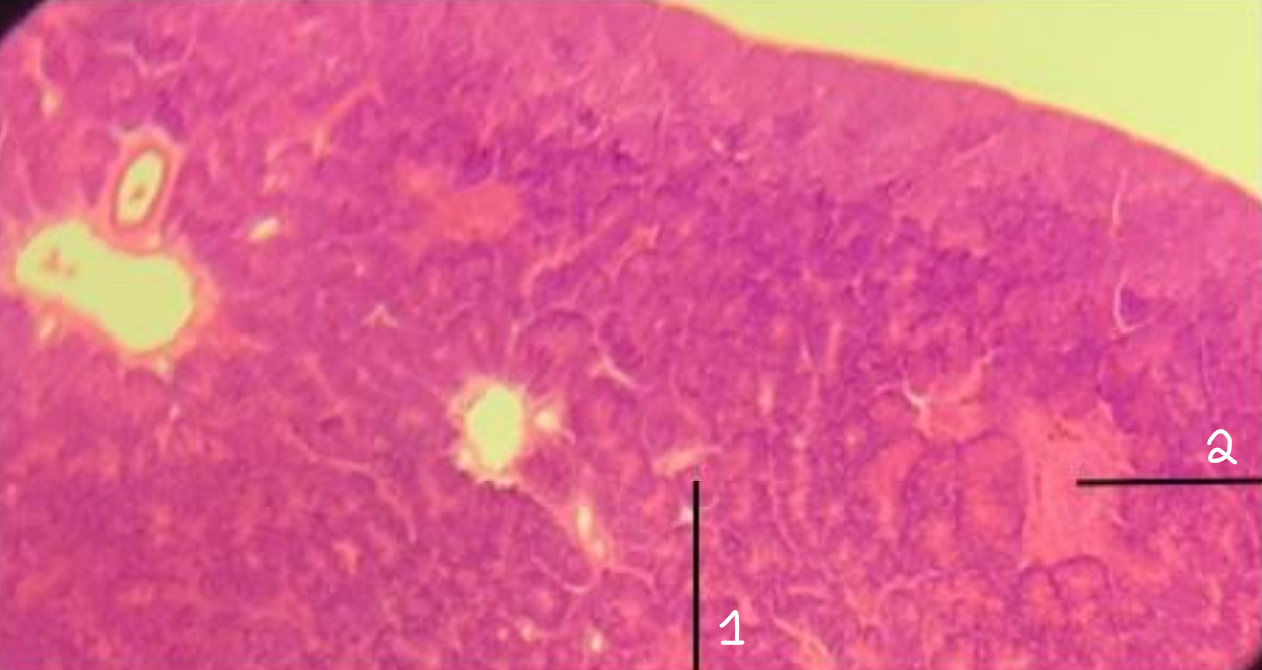
19
New cards
endocrine pancreas
histology of pancreas:
- pancreas that contain iolated pancreatic islet
- secrete hormones
- pancreas that contain iolated pancreatic islet
- secrete hormones
20
New cards
islets of langerhans
histology of pancreas:
- pale-staining structures composed of cells arranged in cords
- have rich capillary network
- secretion will go to blood stream to the body parts
- arrow 2
- has 2 types of cells
- pale-staining structures composed of cells arranged in cords
- have rich capillary network
- secretion will go to blood stream to the body parts
- arrow 2
- has 2 types of cells
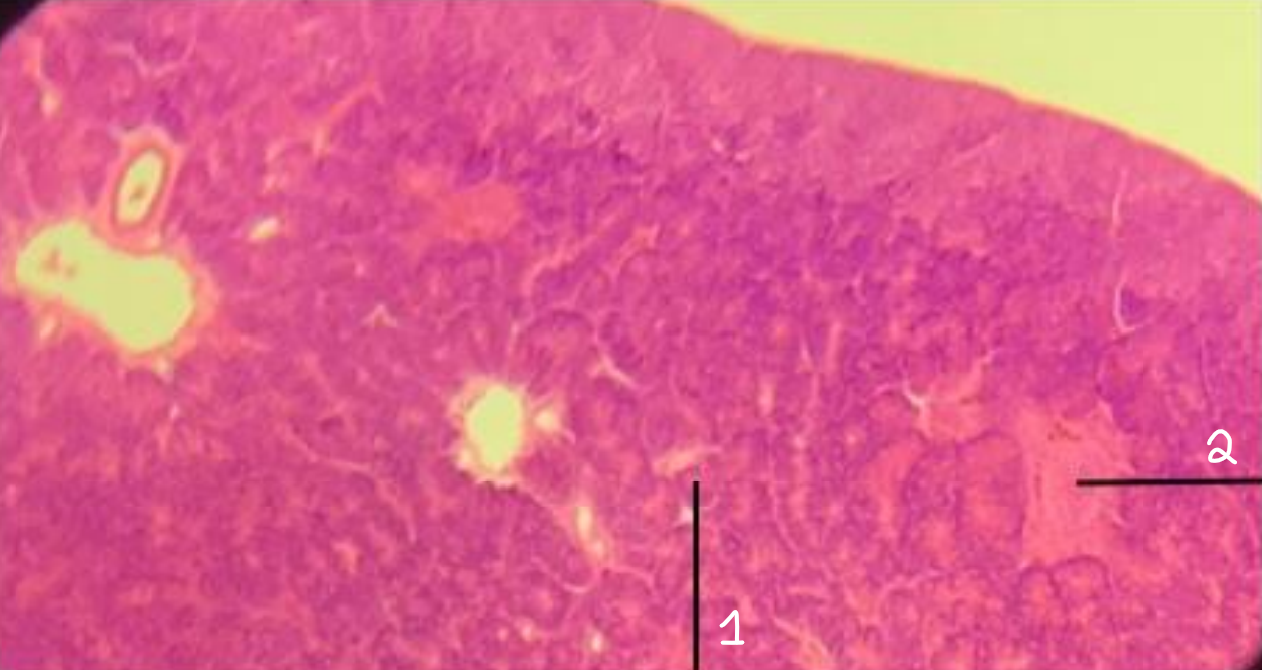
21
New cards
iolated pancreatic islet
aka islets of langerhans
22
New cards
alpha & beta cells
2 types of cells in islets of langerhans
23
New cards
alpha cell
cell in pancreas that secrete glucagon
24
New cards
beta cell
cell in pancreas that secrete insulin
25
New cards
upper and lower lip folds, sulcus marginalis, maxillary teeth, vomerine teeth, eustachian tube, glottis, esophagus, tongue, vocal sacs, eyeball prominences, internal nares, & tuberculum prelinguale
parts of buccal cavity
26
New cards
upper and lower lip folds
part of buccal cavity:
- skin folds in the margin of the upper jaw and lower jaw
- arrow 2 & 6
- skin folds in the margin of the upper jaw and lower jaw
- arrow 2 & 6
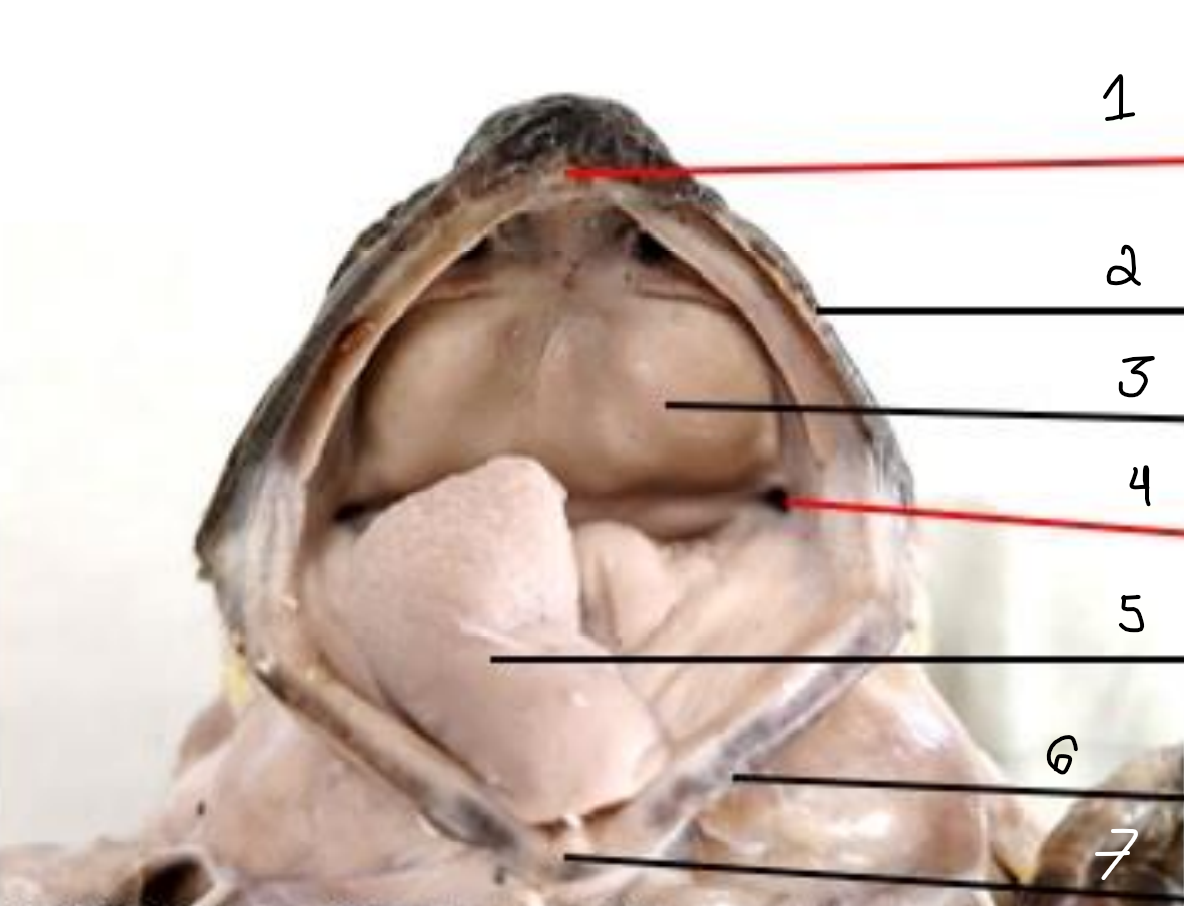
27
New cards
median subrostral fossa
part of buccal cavity:
- prominent depression at the tip of the upper jaw
- arrow 1
- prominent depression at the tip of the upper jaw
- arrow 1
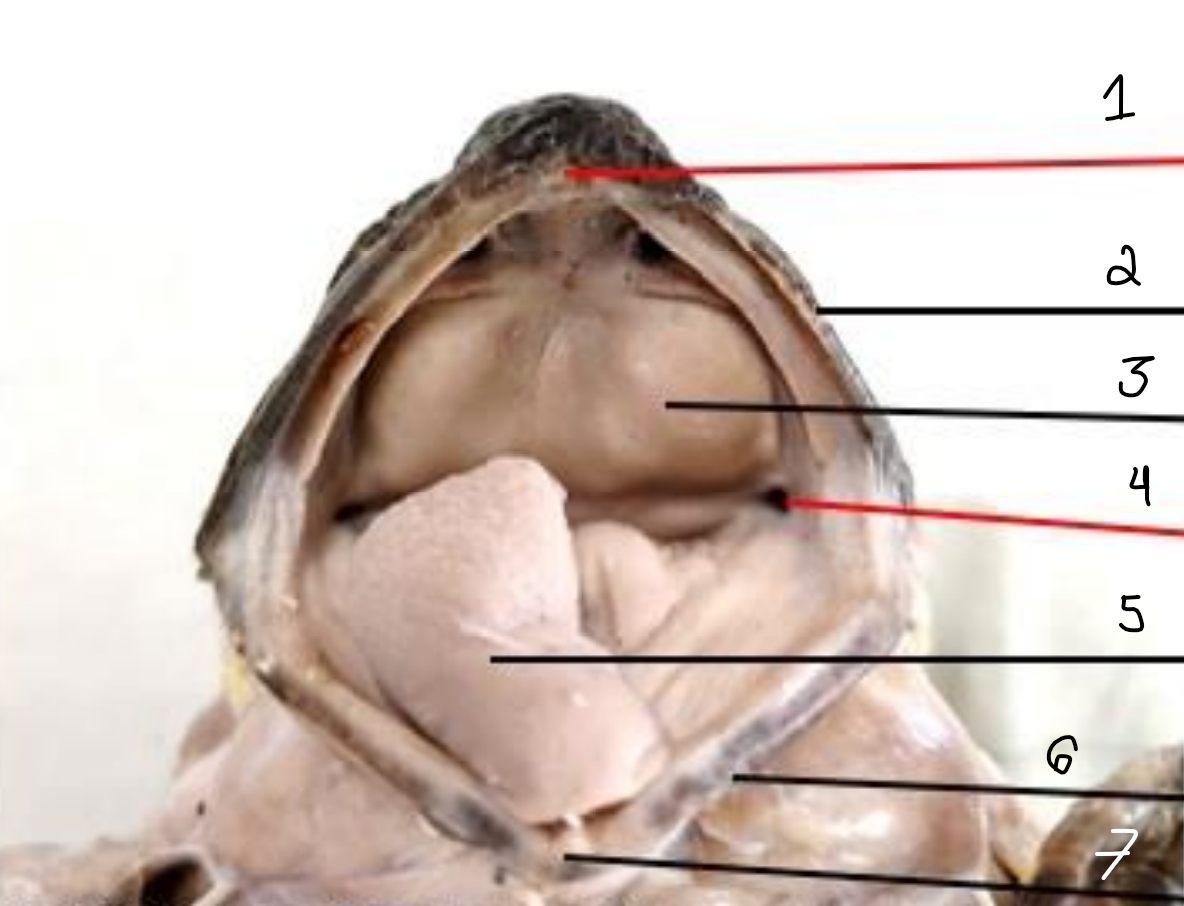
28
New cards
sulcus marginalis
part of buccal cavity:
- pair of deep grooves found at the inner margin of the upper jaw
- receives elevation at the lower jaw
- pair of deep grooves found at the inner margin of the upper jaw
- receives elevation at the lower jaw
29
New cards
maxillary teeth
part of buccal cavity:
- row of small teeth along the margin
- around the upper edge of the jaw
- row of small teeth along the margin
- around the upper edge of the jaw
30
New cards
vomerine teeth
part of buccal cavity:
- used to hold the prey and keep it in place until they can get a good grip on it and squash their eyeballs down to swallow their meal
- set of teeth found on the roof of the mouth
- used to hold the prey and keep it in place until they can get a good grip on it and squash their eyeballs down to swallow their meal
- set of teeth found on the roof of the mouth
31
New cards
eustachian tube
part of buccal cavity:
- pair of openings in the mouth
- tube connects the mouth cavity with the cavities of the middle ear (tympanum)
- posterolateral side of the eyeballs, medial to the angles of the jaw
- equalize air pressure
- arrow 4
- pair of openings in the mouth
- tube connects the mouth cavity with the cavities of the middle ear (tympanum)
- posterolateral side of the eyeballs, medial to the angles of the jaw
- equalize air pressure
- arrow 4
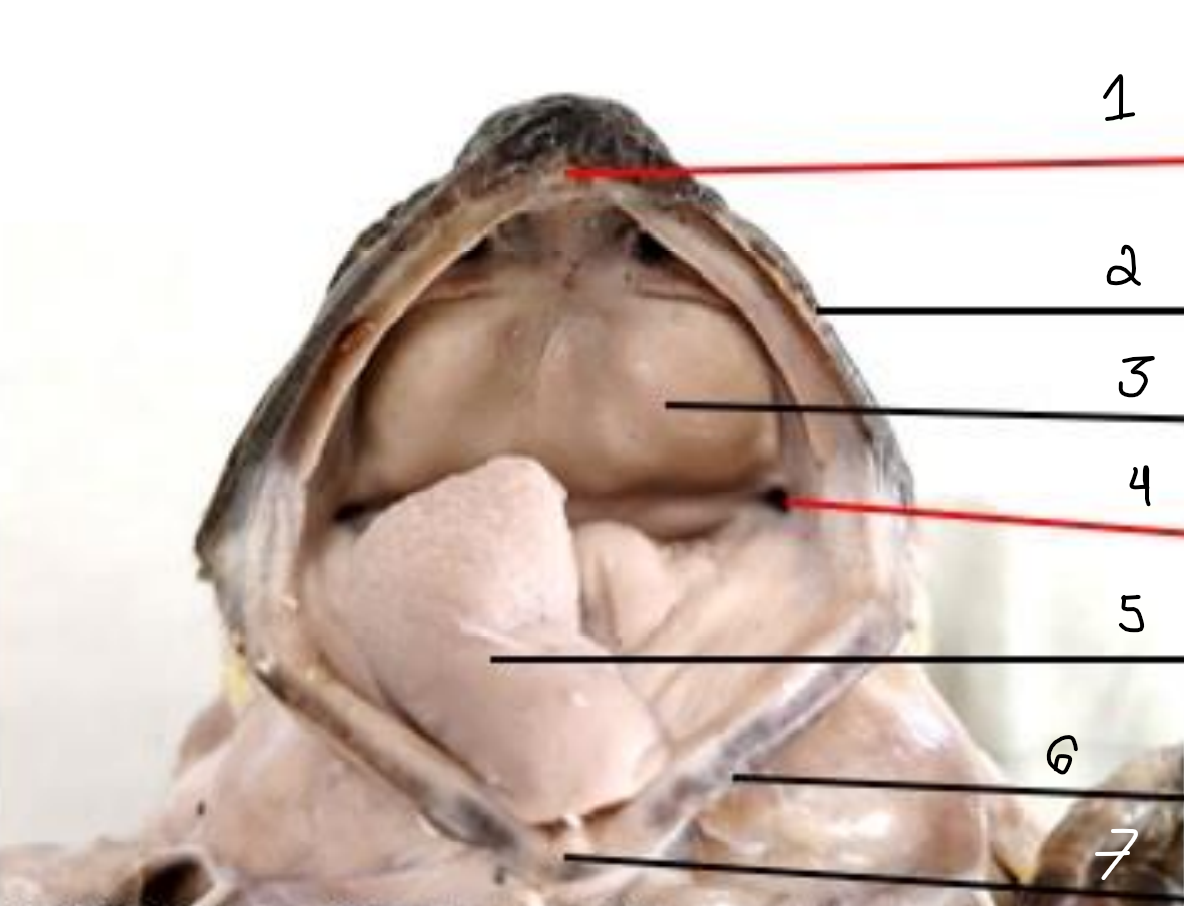
32
New cards
glottis
part of buccal cavity:
- opening at back of mouth leads to lungs
- ventral to the esophagus
- laryngeal prominence with a vertical slit-like opening
- gas exchange
- opening at back of mouth leads to lungs
- ventral to the esophagus
- laryngeal prominence with a vertical slit-like opening
- gas exchange
33
New cards
esophagus
part of buccal cavity:
tube that connects the mouth to the stomach
tube that connects the mouth to the stomach
34
New cards
tongue
part of buccal cavity:
- attached at front of mouth near anterior end by a short pedicle
- extends to catch insects
- arrow 5
- attached at front of mouth near anterior end by a short pedicle
- extends to catch insects
- arrow 5
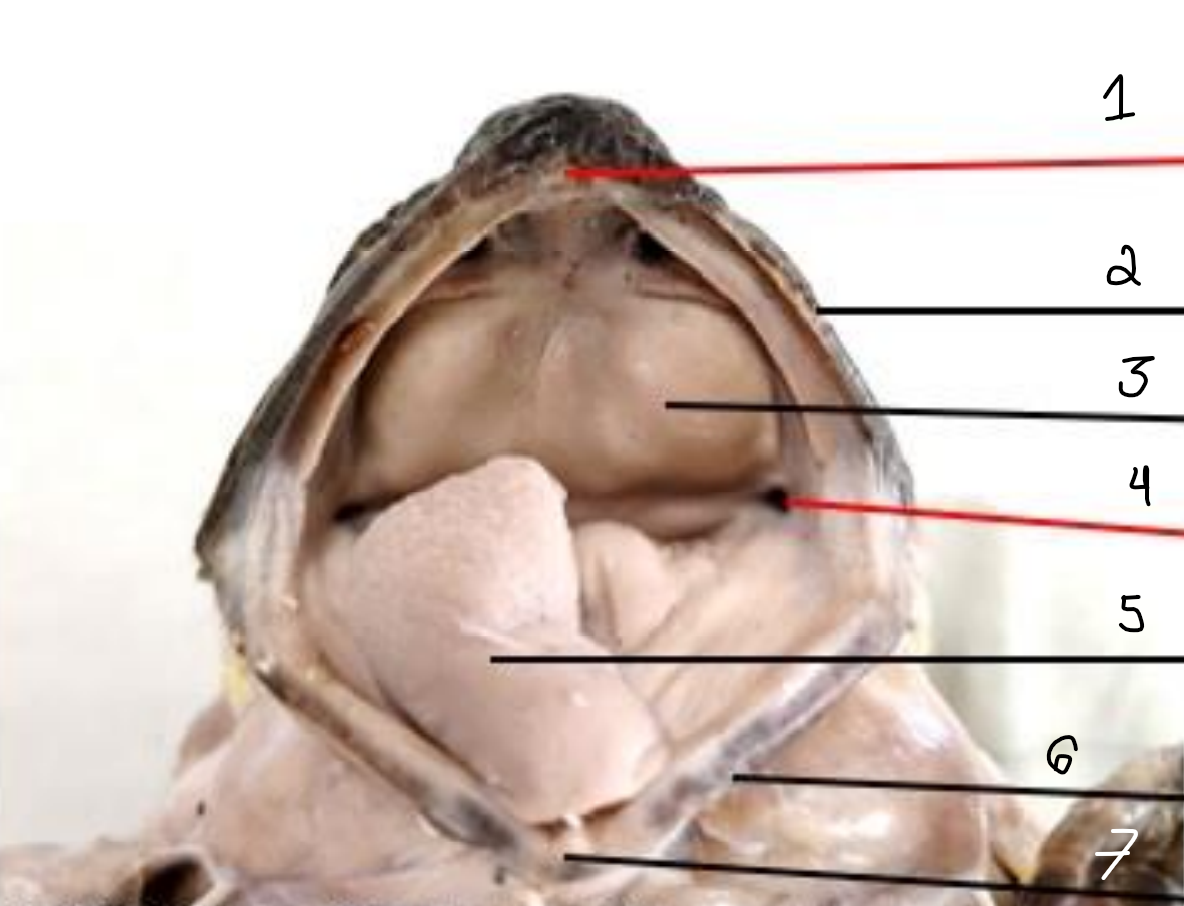
35
New cards
pedicle
part of buccal cavity:
attached tongue to mouth
attached tongue to mouth
36
New cards
vocal sacs
part of buccal cavity:
- 2 slit-like openings
- posterolateral corner of the floor of the tongue
- often lacking in the females
- 2 slit-like openings
- posterolateral corner of the floor of the tongue
- often lacking in the females
37
New cards
eyeball prominences
part of buccal cavity:
- bulging regions at the posterior half of the roof of mouth
- arrow 3
- bulging regions at the posterior half of the roof of mouth
- arrow 3
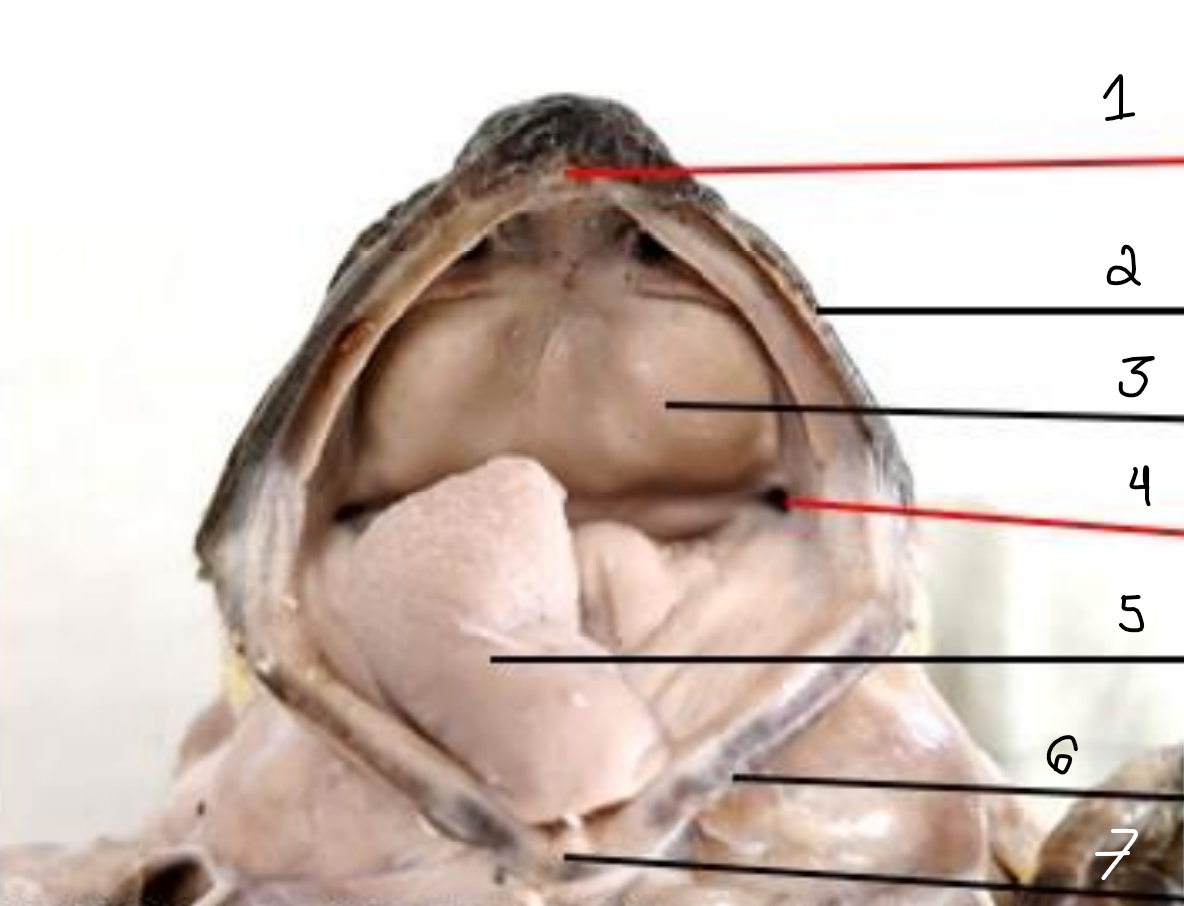
38
New cards
internal nares
part of buccal cavity:
- on top of mouth
- anterolateral openings
- allow gases in and out
- on top of mouth
- anterolateral openings
- allow gases in and out
39
New cards
tuberculum prelinguale
part of buccal cavity:
- located at tip of lower jaw
- median elevation at the tip of lower jaw
- arrow 7
- located at tip of lower jaw
- median elevation at the tip of lower jaw
- arrow 7
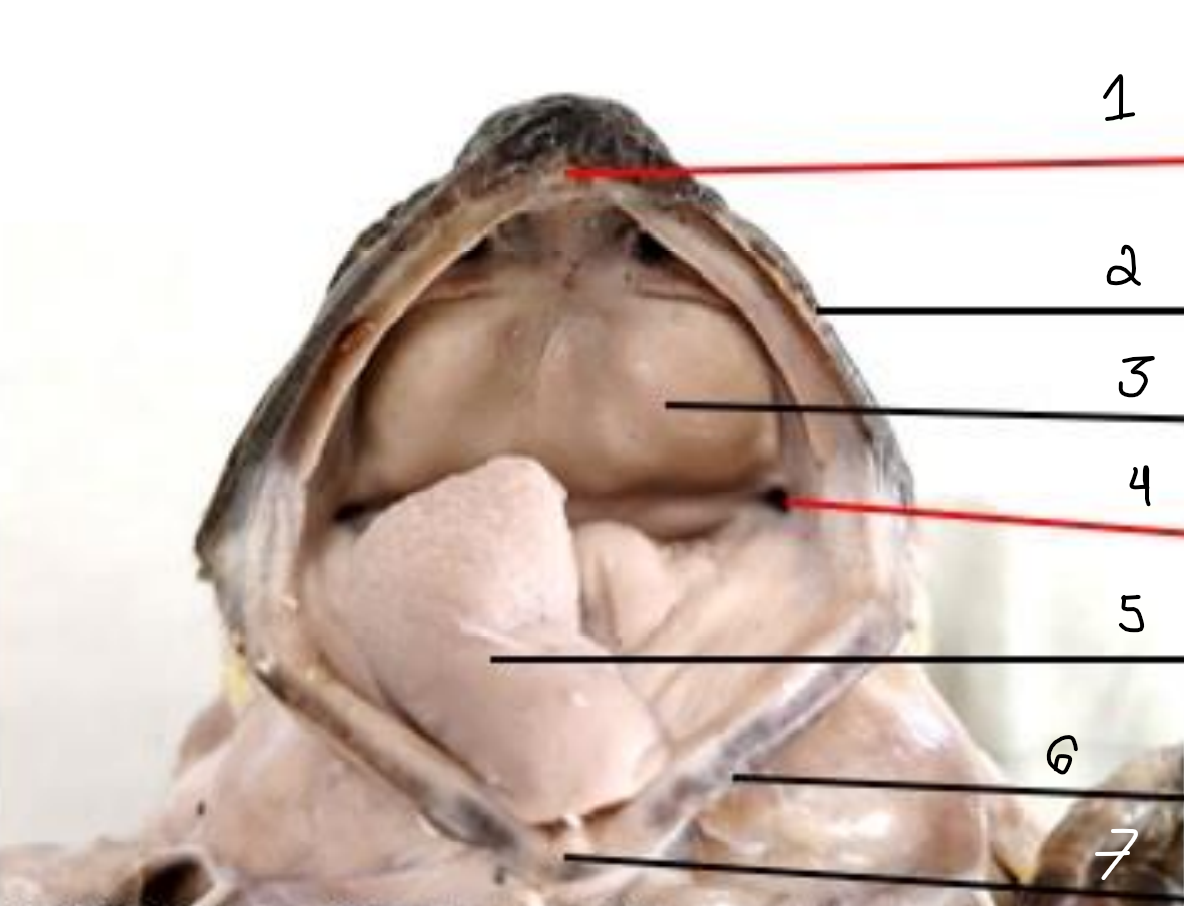
40
New cards
Frog Dissection for digestive system
- ventral side
- cut from cloaca to lower jaw
- "I cut"
- cut from cloaca to lower jaw
- "I cut"
41
New cards
anterior or ventral abdominal vein
- very large vein to the left of the linea alba
- connects to hepatic portal vein
- blue line
- connects to hepatic portal vein
- blue line
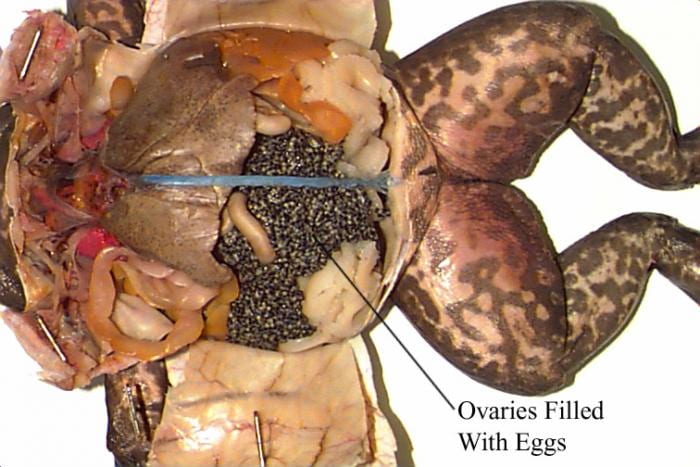
42
New cards
ovaries filled with eggs
female frog if you see their ___
43
New cards
pericardial cavity & pleuroperitoneal cavity
cavities in the toad once opened
44
New cards
pericardial cavity
anterior cavity containing the heart
45
New cards
pleuroperitoneal cavity
posterior cavity housing the lungs and other internal organs & viscera
46
New cards
transverse septum
separates pericardial & pleuroperitoneal cavities
47
New cards
parietal peritoneum
glistening membrane in the inner side of the muscular body wall
48
New cards
visceral peritoneum
extension of parietal peritoneum that forms the covering layer of intestine & other viscera
49
New cards
serosa
aka visceral peritoneum
50
New cards
mesentery
- suspends digestive tract
- extensions of parietal peritoneum
- 2 parts
- extensions of parietal peritoneum
- 2 parts
51
New cards
dorsal & ventral mesentery
2 parts of mesentery
52
New cards
dorsal mesentery
mesentery:
- attaches the digestive tract to the medial dorsal line
- has 2 types
- attaches the digestive tract to the medial dorsal line
- has 2 types
53
New cards
mesentery proper & mesorectum
2 types of dorsal mesentery
54
New cards
mesentery proper
mesentery that supports small intestine
55
New cards
mesorectum
mesentery that supports large intestine
56
New cards
ventral mesentery
mesentery:
- attaches the organs to the midventral line
- lost except in region of liver and urinary bladder
- attaches the organs to the midventral line
- lost except in region of liver and urinary bladder
57
New cards
liver
- large trilobed brownish organ occupying anterior half of pleuroperitoneal cavity
- secretes bile and processes digestive food molecules
- arrow 1
- secretes bile and processes digestive food molecules
- arrow 1
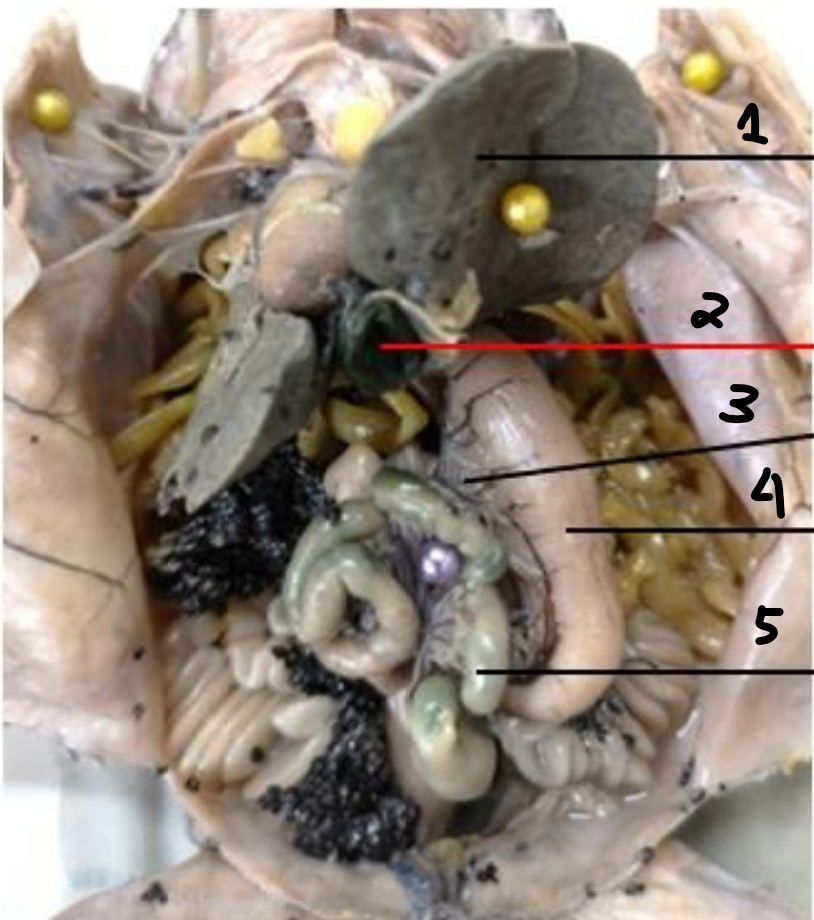
58
New cards
bile
fluid produced by liver that aids in digestion of fats
59
New cards
gall bladder
- greenish spherical sac that stores bile
- found between left and middle liver lobes
- arrow 2
- found between left and middle liver lobes
- arrow 2
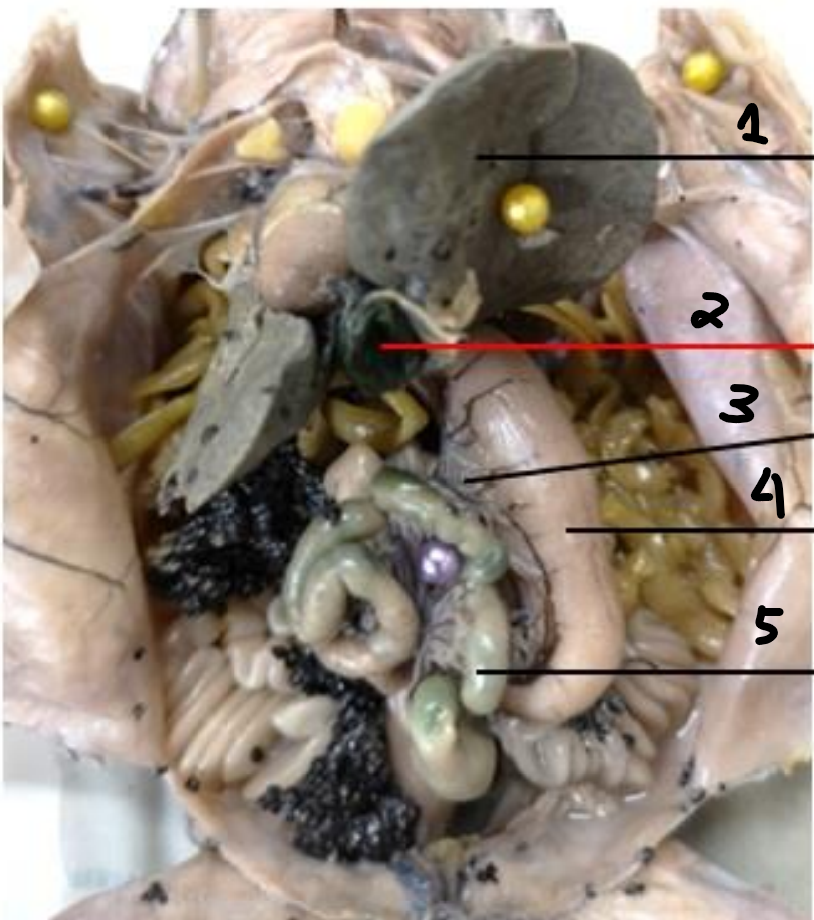
60
New cards
common bile duct
- hepatic ducts from the liver and cystic ducts from the gallbladder join
- enters the duodenum of the small intestine
- lined by simple columnar epithelium
- enters the duodenum of the small intestine
- lined by simple columnar epithelium
61
New cards
stomach
- stores food and mixes it with enzymes to begin digestion
- found behind liver
- contains rugae
- 3 regions
- arrow 4
- found behind liver
- contains rugae
- 3 regions
- arrow 4
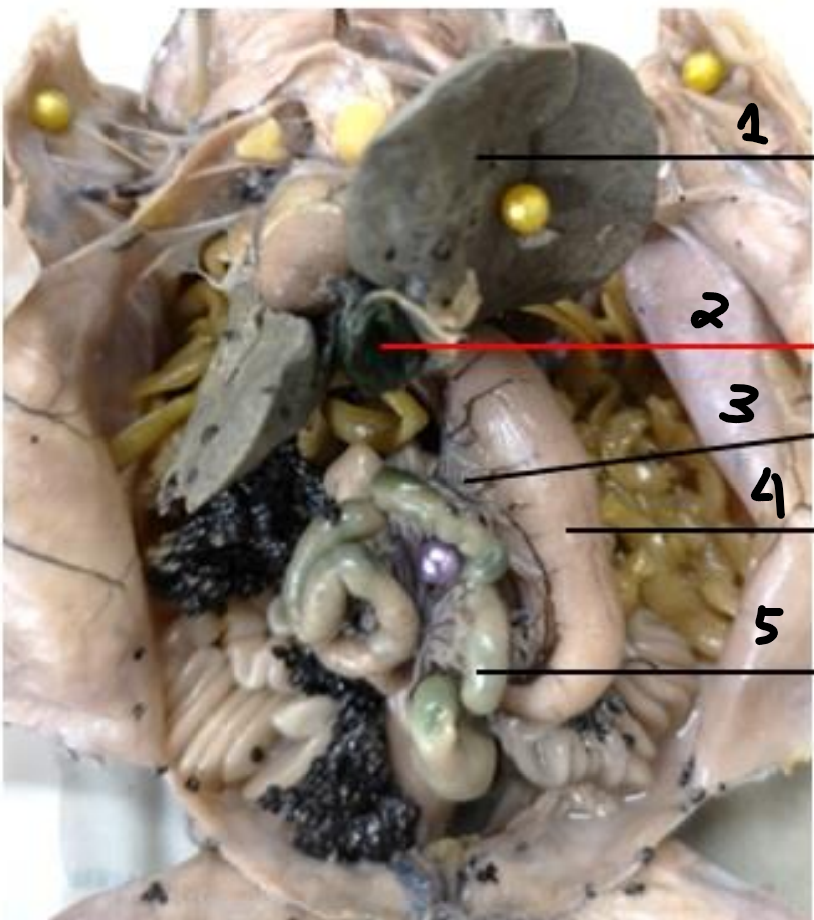
62
New cards
cardiac region, fundus, & pyloric region
3 regions of the stomach
63
New cards
cardiac region
region of the stomach nearest to the esophagus
64
New cards
cardiac sphincter
sphincter that guards cardiac region
65
New cards
fundus
region of the stomach that bulges anteriorly
66
New cards
pylorus
region of the stomach closest to the small intestine
67
New cards
pyloric sphincter
sphincter that guards pyloric region
68
New cards
rugae
longitudinal folds in the inner wall of the stomach
69
New cards
mesogaster
- portion of dorsal mesentery that supports the stomach
- arrow 3
- arrow 3
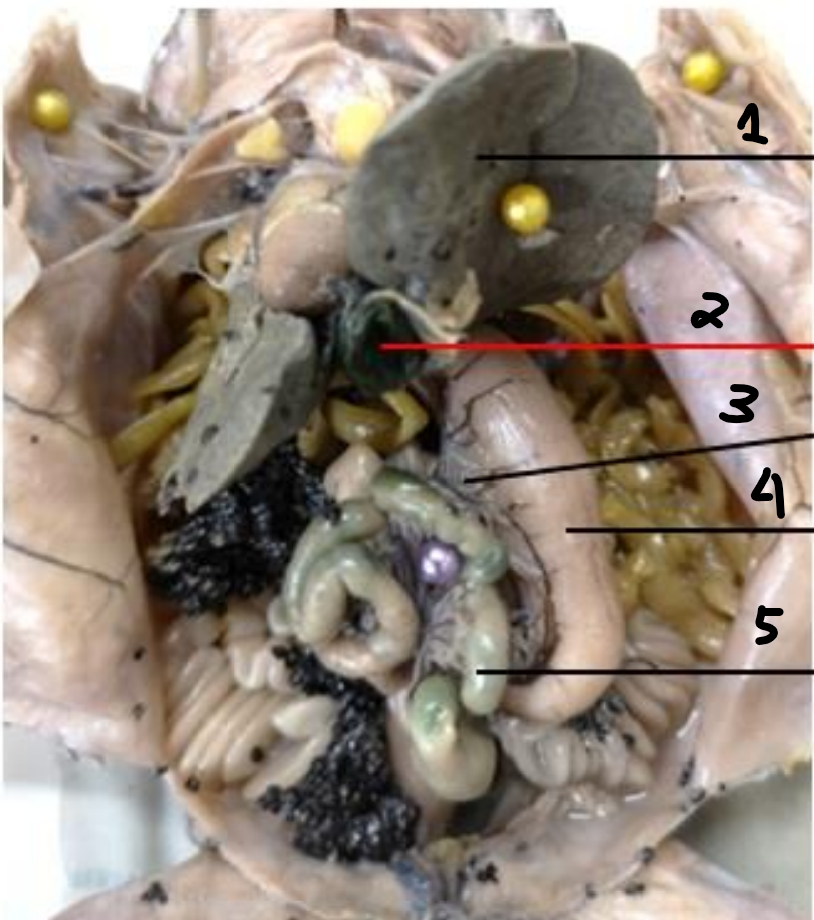
70
New cards
small intestine
- digests and absorb digested food
- found below pylorus
- arrow 5
- found below pylorus
- arrow 5
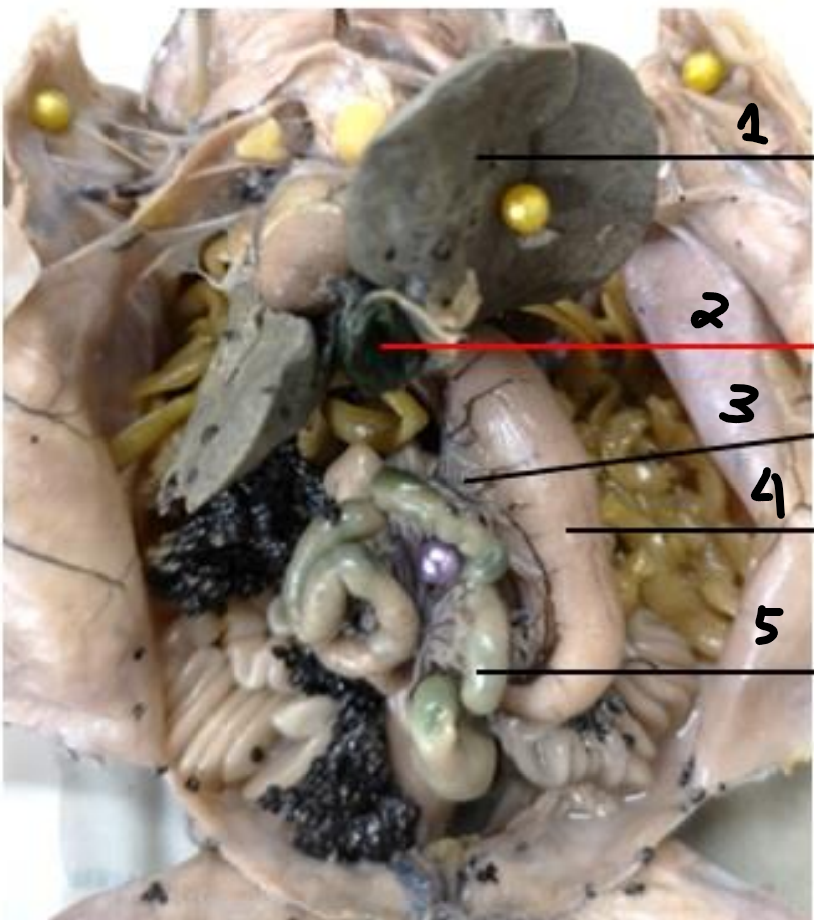
71
New cards
duodenum
short, straight, anterior-most segment of the small intestine
72
New cards
pancreas
- yellowish gland found between pylorus & duodenum
- provides digestive enzymes and bicarbonates that are secreted into the small intestine
- provides digestive enzymes and bicarbonates that are secreted into the small intestine
73
New cards
ileum
part of small intestine that proceeds posteriorly as coiled structure
74
New cards
large intestine
- stores undigested food
- found below small intestine
- found below small intestine
75
New cards
cloaca
- chamber that serves as a common passageway to the outside for both digestive and urogenital systems
- terminates at the cloacal aperture
- anterior to the entry of the mesonephric duct
- terminates at the cloacal aperture
- anterior to the entry of the mesonephric duct
76
New cards
spleen
- organ in circulatory system
- NO digestive function
- round dense body
- makes, stores, and destroys blood cells
- found behind small and large intestines
- NO digestive function
- round dense body
- makes, stores, and destroys blood cells
- found behind small and large intestines

77
New cards
Respiration
- exchange of gases
- has 2 stages
- has 2 stages
78
New cards
ATP
result of oxygen obtained from the environment needed for metabolism
79
New cards
CO2
by-product of metabolism released to the environment
80
New cards
external respiration & internal respiration
2 stages of respiration
81
New cards
external respiration
exchange of gases between the environment and the respiratory organs
82
New cards
internal respiration
exchange of gases between body fluids and tissue cells
83
New cards
nostrils, nasal cavity, pharynx, larynx, trachea, bronchus, bronchioles, alveoli, & blood
flow of respiration
84
New cards
skin, lungs, & mucous lining of mouth
- 3 surfaces of the frog used to exchange gas with the surroundings
- characterized by semi-permeable membrane
- characterized by semi-permeable membrane
85
New cards
skin
- composed of thin membranous tissue
- permeable to water
- contains a large network of blood vessels
- contains mucous glands
- permeable to water
- contains a large network of blood vessels
- contains mucous glands
86
New cards
mucous glands
glands in the skin that keep the frog moist, which help absorb dissolved oxygen from the air
87
New cards
nostrils
- pair of openings at the anterolateral part of the snout
- aka external nares
- opening lead into the internal nares
- aka external nares
- opening lead into the internal nares
88
New cards
larynx
- voice box
- supported or stiffed by cartilages
- has vocal cords in each half
- supported or stiffed by cartilages
- has vocal cords in each half
89
New cards
arytenoid cartilages
anterior pair of cartilages that support larynx
90
New cards
cricoid cartilages
posterior pair of cartilages that support larynx
91
New cards
vocal cords
thin elastic bands in each halves of the larynx
92
New cards
bronchus
- extremely short tube connected to the lungs
- quite difficult to locate
- quite difficult to locate
93
New cards
lungs
- collapsed or egg-shape
- membranous sacs
- lined by alveoli
- red arrow
- membranous sacs
- lined by alveoli
- red arrow

94
New cards
collapsed
lung shape of preserved toad
95
New cards
egg-shaped
lung shape of living toad
96
New cards
alveoli
- numerous chambers of the lungs that sometimes interconnect with one another
- small air pockets
- where gas exchange takes place
- connected to blood vessels
- arrow 1
- small air pockets
- where gas exchange takes place
- connected to blood vessels
- arrow 1
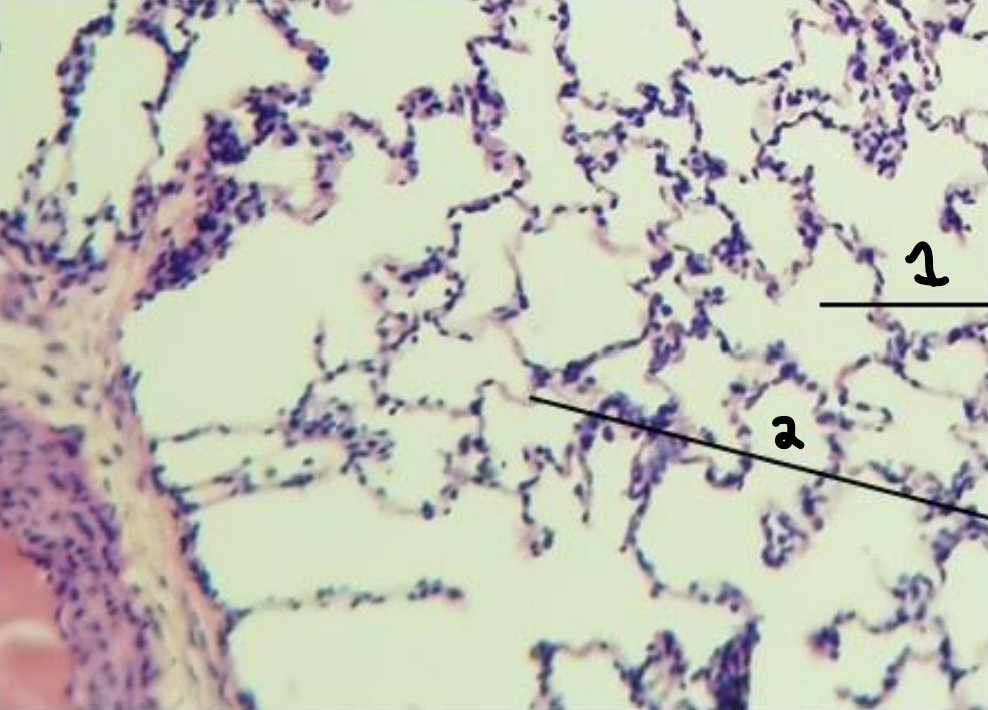
97
New cards
interalveolar septum
- very thin partition between alveoli
- arrow 2
- arrow 2
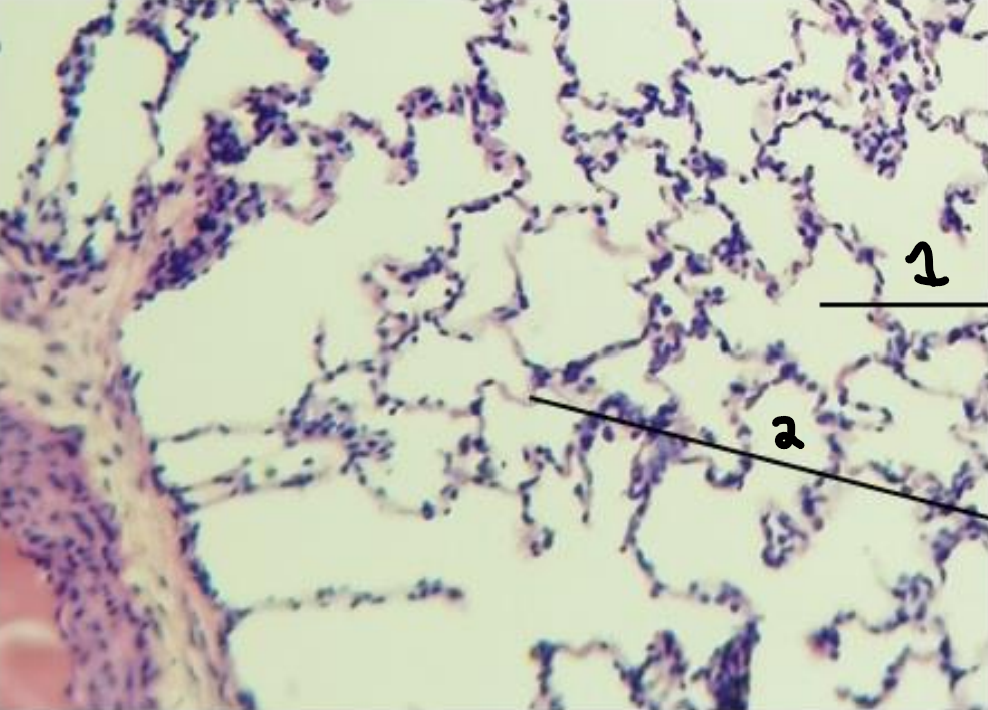
98
New cards
bronchiole
- branches from bronchus to alveoli
- part A
- part A
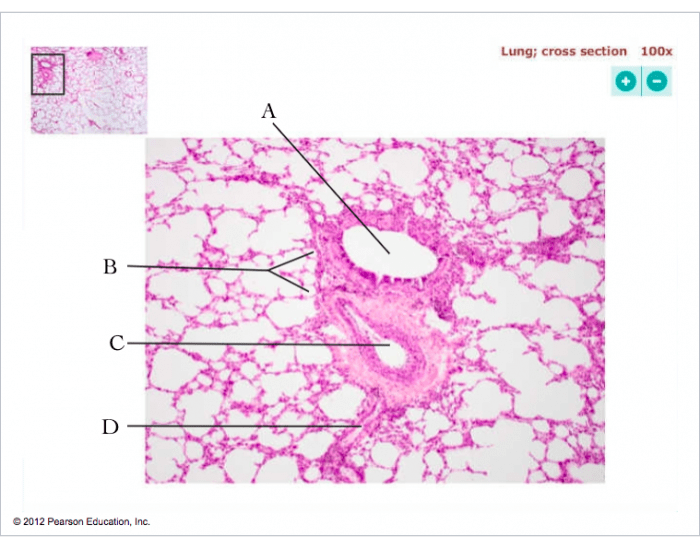
99
New cards
Circulatory System
functions of organ system:
- transport of respiratory gases, food materials, waste products, hormones, and minerals within the body
- defense against foreign organisms
- maintenance of body temperature in warm-blooded or homeothermic animals
- transport of respiratory gases, food materials, waste products, hormones, and minerals within the body
- defense against foreign organisms
- maintenance of body temperature in warm-blooded or homeothermic animals
100
New cards
Open & Closed Circulatory System
2 Types of Circulatory System